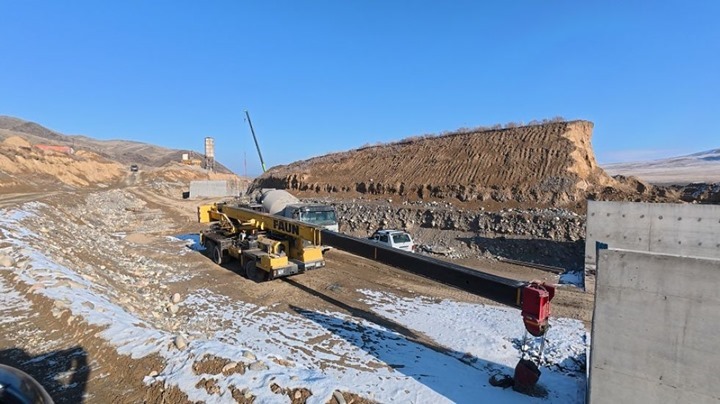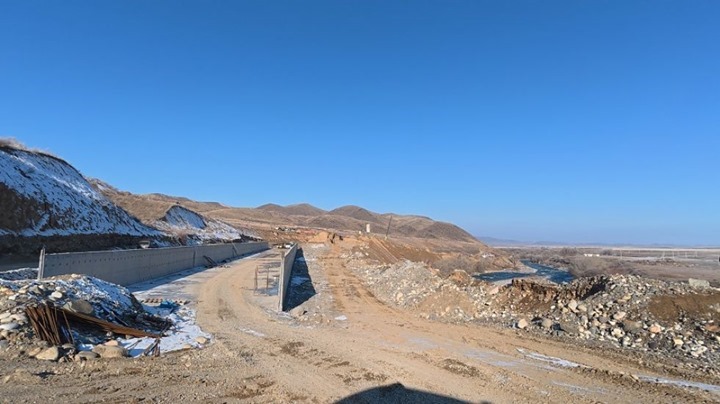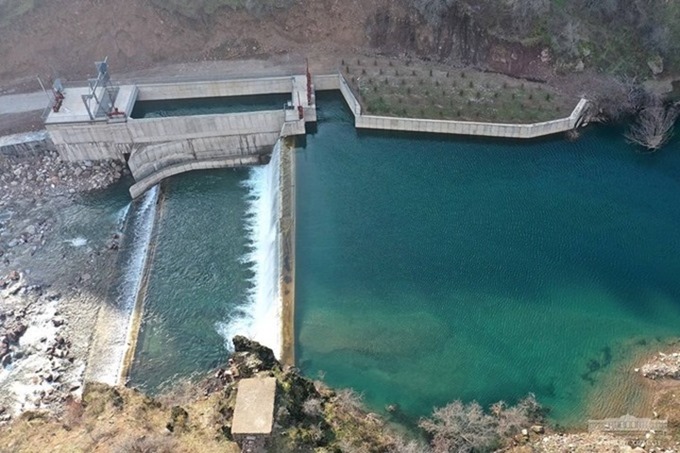Small hydroelectric power plants begin to destroy the mountain rivers Zhetysu
Since the beginning of this year, scandals around the construction of small hydroelectric power stations on the rivers Kora, Chazha and Koksu have not subsided in Zhetysu. If the construction of hydroelectric power stations on the first two mountain streams is almost completed or is being completed, then the construction of several hydroelectric power stations on the Koksu River is just beginning and seriously excites the minds and imagination of civil activists.

We wrote about two small hydroelectric power plants that are being built on the Koksu River three kilometers from the village of Rudnichny last summer. Then the local authorities could not explain to us in any way where and when public hearings on these projects were held, and the local foresters in their response to our official request stated that they had not given any permission for the construction of hydraulic structures on their territory. Now it turns out that the grandiose construction is in full swing there, and the locals notice suspicious changes taking place on the riverbank.
— The Koksu River is a kind of river, with its own character. She demolished many sites. They want to put up dams here before spring. If there is a flood, then everything here will be demolished,” says Alexey Malyutin, a resident of the village of Rudnichny.
Saltanat Uteshbaeva, a civil activist from Koksu district, a lover of water rafting on mountain rivers, fully agrees with the opinion of Alexei Malyutin. According to the woman, the Koksu River is unique in that rafting athletes from all over the world come here. And also, Saltanat says, the river has a mobile bottom and banks.
— Even in the USSR, scientists believed that it was impossible to build hydraulic structures on the Koksu River. Currently, greedy businessmen and corrupt officials, without thinking about the safety of hydroelectric power plants and their necessity, are handing out permits. For the sake of momentary benefits, they let our natural heritage under excavators,” Saltanat Uteshbayeva is sure.
Rinat KHAMZIN, another eco-activist from Eskeldinsky district, posted a video on his Instagram page the day before about another hydroelectric power station, which began to be built on the Koksu River in the district of the same name. We have sent an official request to the Department of Natural Resources and Environmental Management of the Zhetysu region about who is building this HPP and why. But for some reason, the management sent us an answer regarding the hydroelectric power station near the village of Rudnichny, which we wrote about earlier. The akimat of Koksu district reports the following:
“The purpose of the construction of the Verkhne-Talaptinskaya HPP on the Koksu River is aimed at the development of renewable energy, ensuring sustainable and balanced economic growth through the effective development of the electric power industry, improving the structure of the electricity market, promoting the development of electricity production in the Zhetysu region. Formation of guaranteed volumes of electricity and ensuring energy independence.
The implementation of the project has attracted investments to the district, new jobs will be created, and the volume of tax revenues to the budget will increase. The work on the construction of the Verkhne-Talaptinsky HPP is carried out on the basis of design estimates approved by authorized bodies and state expertise. The operation of the HPP is not accompanied by the release of carbon monoxide and carbon dioxide, nitrogen and sulfur oxides, dust pollutants and other harmful waste, does not pollute the soil compared to other sources of electricity generation.”
We decided to find out about the exact number of HPPs being built on the small Koksu River from the head of the Department of Natural Resources and Environmental Management of the region, Zhetysu Eldos MYRZABEK. That’s just the official could not tell us clearly about where and who is building gas stations in Zhetysu. He advised to find out about it in the Department of energy and housing of the region.
However, the head of this department, Aidos BEKETAYEV, assured that he was also not aware of the construction of new HPPs and sent us to the regional Department of entrepreneurship and innovative development. They say that all HPPs are being built under the renewable energy (renewable energy sources) program. Whether this is so, we have not been able to find out.

In the plan for the development of the hydropower industry of Kazakhstan for the period from 2020 to 2030, signed by Deputy Prime Minister Roman Sklyar, we discovered a long stream of hydroelectric power plants that are being built on the Koksu River. And, as it turned out, there are almost a dozen of them. These are: Rudnichnye HPPs -1 and HPPS -2 with a capacity of 19 and 23 MW, Kyzylkungey HPPs with a capacity of 40 MW, Talapty – 150 MW, Verkhne-Talaptinskaya – 48 MW, Kyzylbulak – 100 MW, Cascades of HPPs – 37, 2 MW.
The question of whether it is possible to build so many hydroelectric power stations on the small Koksu River, with a length of only 206 km, we addressed to the specialists of the Balkhash-Alakol water Inspectorate.
— According to the provisions of Article 125 of the Water Code, the placement, design and construction of facilities on water bodies and in their water protection zones and strips requires compliance with a number of conditions and approvals. At the same time, the prohibiting norms relate primarily to economic activities that worsen the condition of water bodies, as well as the construction of those structures that are not included in the list of exceptions. In this list there are facilities for the use of renewable energy sources, including hydrodynamic energy of water, which include small hydroelectric power plants.
Small hydroelectric power plants are designed and built in compliance with all the requirements of environmental, sanitary-epidemiological, urban planning and other special legislation. Projects should receive positive conclusions of a comprehensive non-departmental examination. Since water during the operation of small hydroelectric power plants is usually returned back to the riverbed (that is, there is no consumption or pollution on a significant scale), this reduces the risk of negative impact on the ecological state of the water body. Thus, it is theoretically possible to place a number of small hydroelectric power stations on the Koksu River, provided that all the norms and requirements of the legislation are met,” the head of the inspection department, Botagoz ORAZBEKOVA, explained to us.

Eco-activist Sergey TANDEEV recently visited the coast of the Chazha and Kora rivers near the city of Tekeli. The coast of mountain streams has already been significantly turned around here, as ASPMK – 519 LLP has built a hydroelectric power station with a capacity of 25.8 MW here. At the confluence of the rivers Kora and Chazha, they are building another HPP with a capacity of 12.5 MW.
— There used to be a narrow path to these mountain rivers, now there is a huge gravel strip. All the trees have been cut down, many springs have disappeared. According to fishermen and hunters, fish are disappearing in rivers, bears and many other animals have disappeared,” says Sergey Tandeev.
The deputy head of the NGO “Green Solidarity” Aidar Khadzhimuratov expressed his indignation at the officials.
While I was going around civil servants in different offices, I was firmly convinced: There are temporary dropouts everywhere. Firstly, no one was able to explain how the places on the Koksu River were selected for the construction of the hydroelectric power station, who gave them the conclusions? Secondly, none of them took responsibility for the decisions taken. Everyone sent me to different offices, referring to each other,” Khadzhimuratov is indignant.
The head of the public chamber of Eskeldinsky district Vladimir NATOCHIY turned out to be more specific and without fear called the name of the main “culprit” of the ecological lawlessness on the Koksu River.
— The akim of the region, Beibit Isabayev, is to blame for everything. He sits quietly in a chair, waiting for retirement. If he was a patriot and worried about the nature of Zhetysu, he would have expressed his point of view long ago. Why ruin rivers if they will build nuclear power plants on Balkhash anyway? The Koksu River originates in the mountains from the melting of glaciers, it may soon disappear, then how will the new hydroelectric power stations work? There is a precedent in the region – the Balakhty River has disappeared, there is no water left at all,” says Vladimir Natochiy.
The state renewable energy construction program has been implemented in Kazakhstan for 15 years. The state compensates for a substantial part of the costs of private owners building hydroelectric power stations, solar and wind farms. Perhaps that is why crowds of “investors” are besieging the Zhetysu River today in the hope of getting decent compensation. And our dashing businessmen are very capable of this. For example, when receiving subsidies for the development of animal husbandry, they have become so rampant that now they cannot find 2 million heads of cattle and 3 million small farm animals in the government. They say there were unthinkable postscript.
Aliya Akhmedieva (Ratel.kz )


